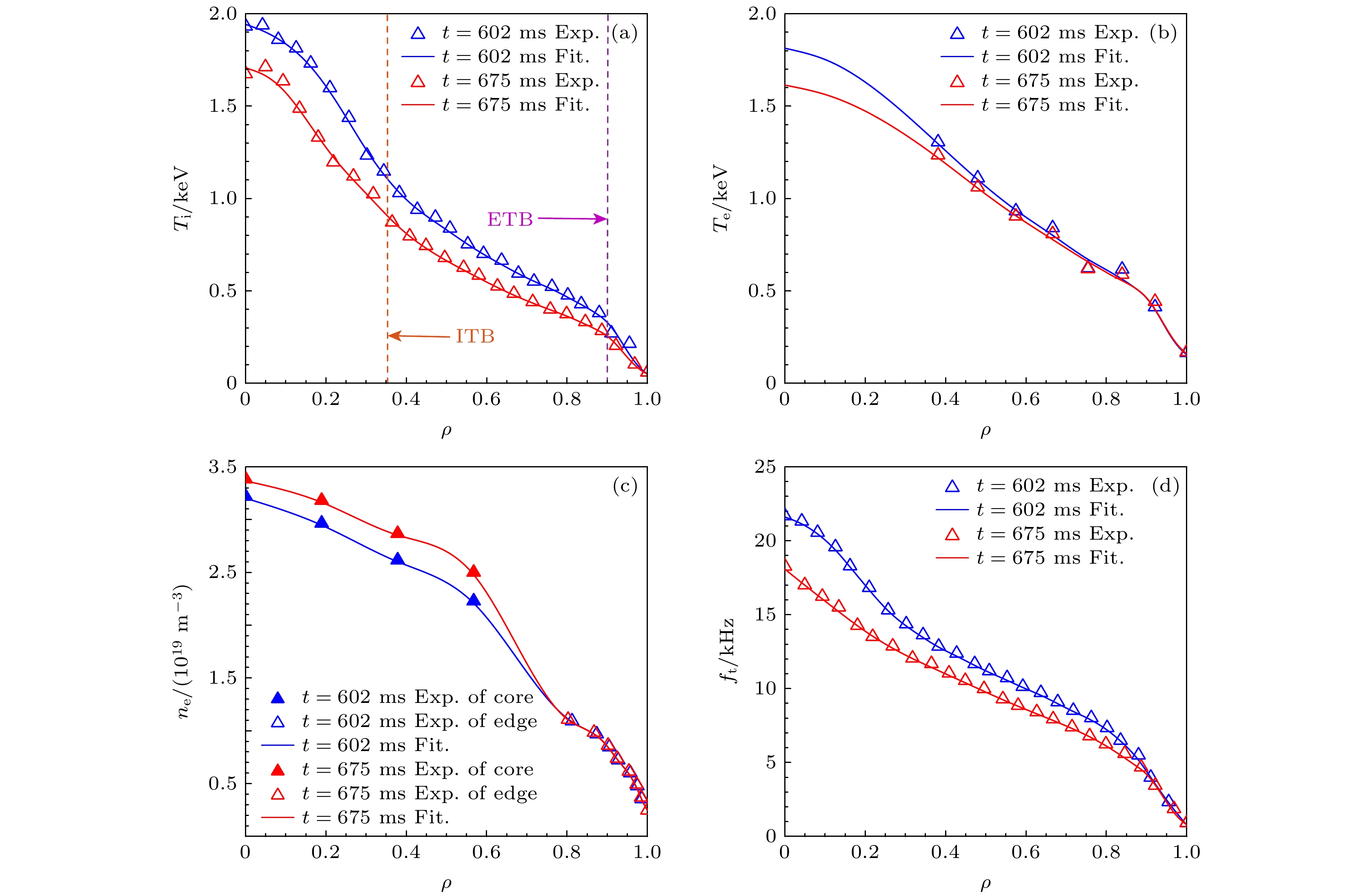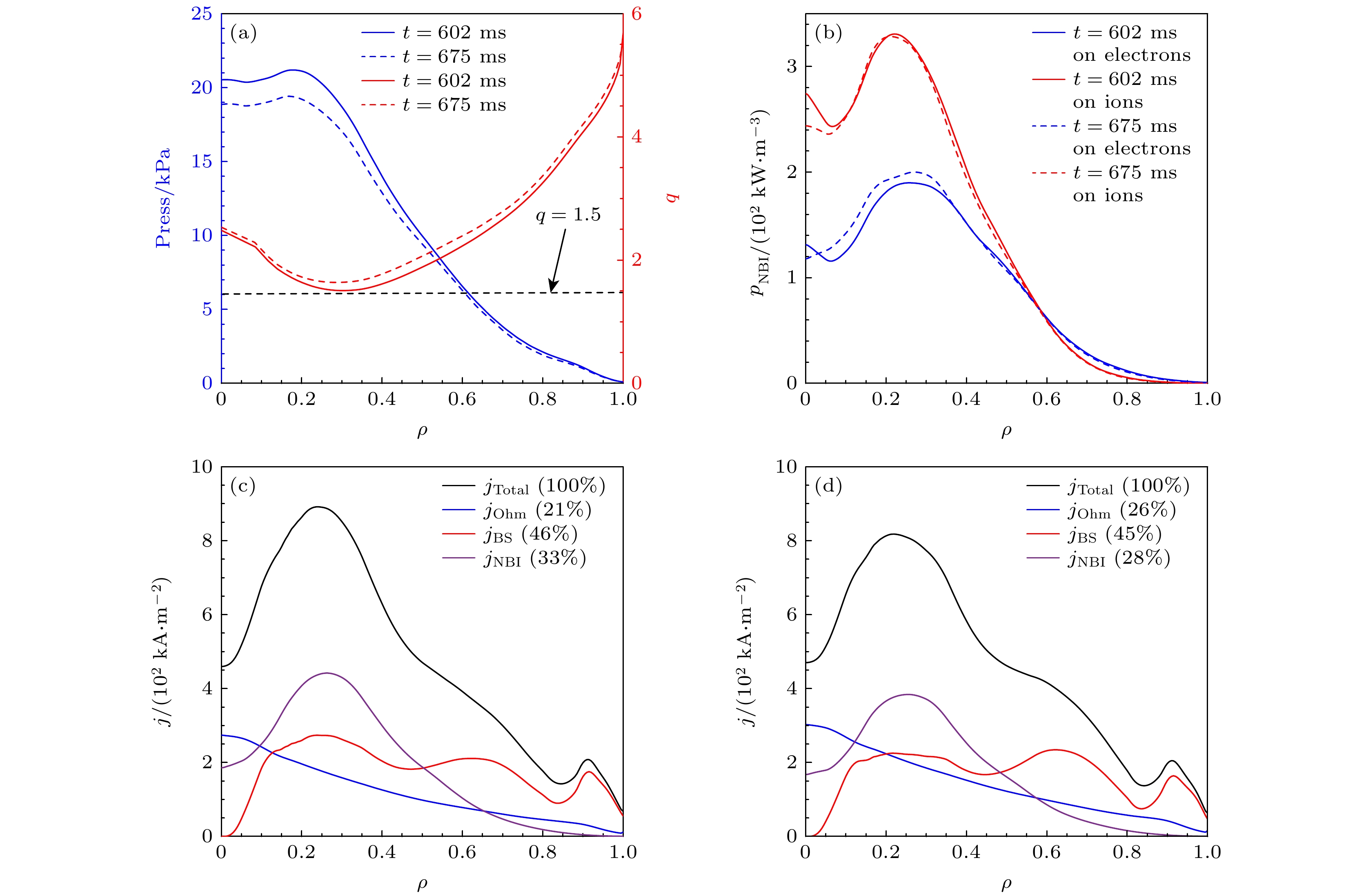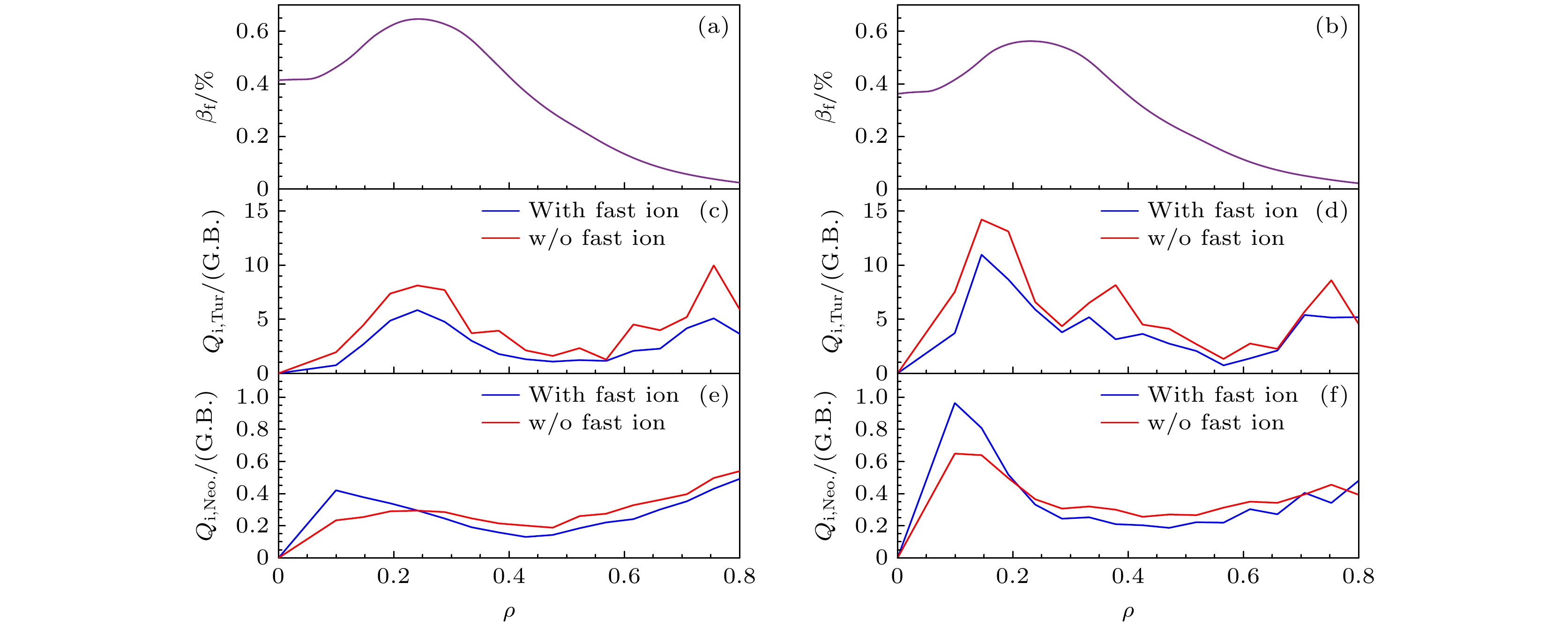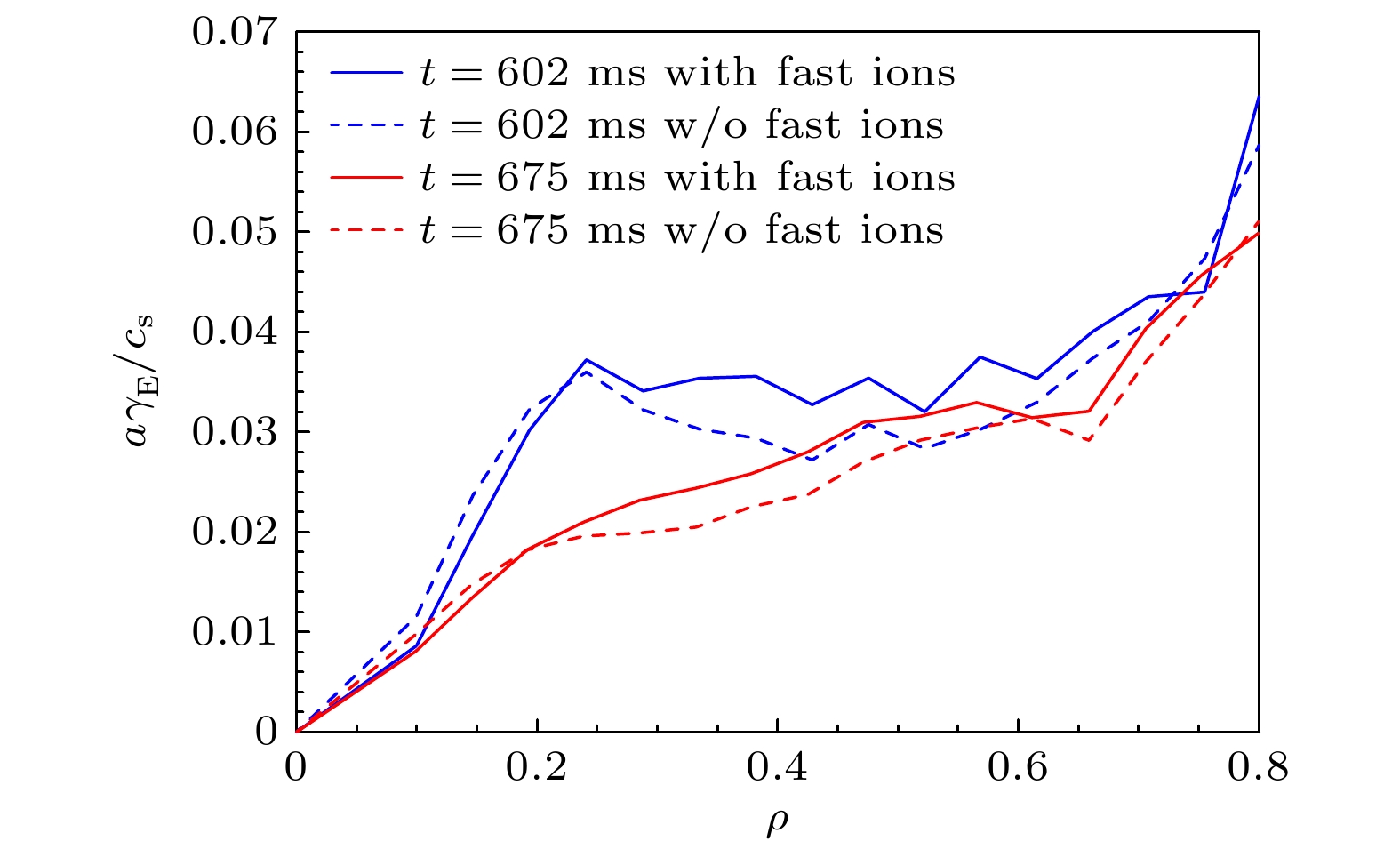-
Tokamak is considered as the most promising experimental setup for achieving controllable nuclear fusion requirements. The parameter
$\beta_{\rm{N}}$ is an important parameter for tokamak devices: high$\beta_{\rm{N}}$ benefits not only to plasma fusion but also to the enhancement of fusion reaction efficiency and the facilitation of steady-state operation. The HL-2A tokamak device has achieved stable plasma with$\beta_{\rm{N}}$ exceeding than 2.5 through neutral beam injection heating, and transiently reached$\beta_{\rm{N}}$ = 3.05, with a normalized density ($n_{\rm{e,l}}/n_{\rm{e,G}}$ ) of about 0.6, stored energy ($W_{\rm{E}}$ ) of around 46 kJ, and confinement improvement factor ($H_{98}$ ) of about 1.65. In this work, the integrated simulation platform OMFIT is used to analyze the plasma at$\beta_{\rm{N}}$ = 2.83 and$\beta_{\rm{N}}$ = 3.05, and the obtained$W_ {\rm{E}}$ ,$n_{\rm{e,l}}/n_{\rm{e,G}}$ ,$H_{98}$ ,$\beta_{\rm{N}}$ , etc. are consistent with the experimental parameters. The bootstrap current ($f_{\rm{BS}}$ ) can reach to$45{\text{%}}$ and$46{\text{%}}$ . At both of the above moments, there are ion temperature double transport barrier (DTB) generated by the coexistence of internal transport barrier (ITB) and edge transport barrier (ETB), while high$\beta_{\rm{N}}$ is usually related to DTB. In addition, the formation of ion temperature ITB in the HL-2A device is further analyzed, which is attributed to the dominance of turbulent transport in plasma transport, the suppression of turbulent transport in the core by fast ions and${\boldsymbol E}\times{\boldsymbol B}$ shear, and the resulting improvement in confinement, thereby ultimately leading to the formation of ion temperature ITB. The ITB of ion temperature and the ETB of H-mode synergistically contribute to the creation of high$\beta_{\rm{N}}$ plasma.-
Keywords:
- HL-2A /
- High-βN /
- OMFIT integrated simulation /
- fast ion /
- internal transport barrier
[1] Gormezano C, Sips A C C, Luce T C, et al. 2007 Nucl. Fusion 47 S285
 Google Scholar
Google Scholar
[2] Doyle E J, Houlberg W A, Kamada Y, et al. 2007 Nucl. Fusion 47 S18
 Google Scholar
Google Scholar
[3] Buttery R J, Covele B, Ferron J, et al. 2019 Journal Fusion Energy 38 72
 Google Scholar
Google Scholar
[4] Staebler G M, Garofalo A M, Pan C, et al. 2018 Phys. Plasmas 25 056113
 Google Scholar
Google Scholar
[5] Ding S, Garofalo A M, Knolker M, et al. 2020 Nucl. Fusion 60 034001
 Google Scholar
Google Scholar
[6] Knolker M, Evans T E, Snyder P B, et al. 2021 Plasma Phys. Control. Fusion 63 025017
[7] Greenfield C M, Burrell K H, DeBoo J C, et al. 2001 Phys. Rev. Lett. 86 4544
 Google Scholar
Google Scholar
[8] Wukitch S J, Boivin R L, Bonoli P T, et al. 2002 Phys. Plasmas 9 2149
 Google Scholar
Google Scholar
[9] Fujita T, Ide S, Kamada Y, et al. 2001 Phys. Rev. Lett. 87 085001
 Google Scholar
Google Scholar
[10] Kamada Y, JT-60 Team 2001 Nucl. Fusion 41 1311
 Google Scholar
Google Scholar
[11] Tuccillo A A, Crisanti F, Litaudon X, et al. 2006 Nucl. Fusion 46 214
 Google Scholar
Google Scholar
[12] Chen W, Wang Z X 2020 Chin. Phys. Lett. 37 125001
 Google Scholar
Google Scholar
[13] Chen W, Yu L M, Xu M, et al. 2022 Fundam. Res. 2 667
 Google Scholar
Google Scholar
[14] Meneghini O, Smith S P, Lao L L, et al. 2015 Nucl. Fusion 55 083008
[15] Jian X, Chen J L, Chan V S, et al. 2017 Nucl. Fusion 57 046012
 Google Scholar
Google Scholar
[16] Pan C, Staebler G M, Lao L L, et al. 2017 Nucl. Fusion 57 036018
 Google Scholar
Google Scholar
[17] Jian X, Holland C, Candy J, et al. 2019 Phys. Rev. Lett. 123 225002
 Google Scholar
Google Scholar
[18] Snyder P B, Hughes J W, Osborne T H, et al. 2019 Nucl. Fusion 59 086017
 Google Scholar
Google Scholar
[19] Duan X R, Ding X T, Dong J Q, et al. 2009 Nucl. Fusion 49 104012
 Google Scholar
Google Scholar
[20] Wei Y. L, Yu D L, Liu L, et al. 2014 Sci. Instrum. 85 103503
 Google Scholar
Google Scholar
[21] Shi Z B, Jiang M, Huang X L, et al. 2014 Sci. Instrum. 85 023510
 Google Scholar
Google Scholar
[22] Li Y G, Zhou Y, Li Y, et al. 2017 Rev. Sci. Instrum. 88 083508
 Google Scholar
Google Scholar
[23] Shi Z B, Zhong W L, Jiang M 2018 Plasma Sci. Technol. 20 094007
 Google Scholar
Google Scholar
[24] Sips A C C 2005 Plasma Phys. Control. Fusion 47 A19
 Google Scholar
Google Scholar
[25] Garcia J, Challis C, Citrin J, et al. 2015 Nucl. Fusion 55 053007
 Google Scholar
Google Scholar
[26] Citrin J, Jenko F, Mantica P, et al. 2013 Phys. Rev. Lett. 111 155001
 Google Scholar
Google Scholar
[27] Citrin J, Garcia J, Görler T, et al. 2015 Plasma Phys. Control. Fusion 57 014032
 Google Scholar
Google Scholar
[28] Chen L, Qiu Z Y, Zonca F 2023 Nucl. Fusion 63 106016
 Google Scholar
Google Scholar
[29] Waltz R E, Staebler G M, Dorland W, et al. 1997 Phys. Plasmas 4 2482
 Google Scholar
Google Scholar
[30] Diamond P, Itoh S I, Itoh K, et al. 2005 Plasma Phys. Control. Fusion 47 R35
 Google Scholar
Google Scholar
[31] Burrell K H 1997 Phys. Plasmas 4 1499
 Google Scholar
Google Scholar
-
图 1 HL-2A装置27055次高$\beta_{\rm{N}}$放电实验主要参数随时间的演化 (a)等离子体电流$I_{\rm{p}}$; (b)电子线平均密度$n_{\rm{e, l}}$; (c) NBI注入和低混杂波电流驱动功率$P_{\rm{NBI}}$和$P_{\rm{LHCD}}$; (d)氘阿尔法辐射$D_{\alpha}$信号; (e)等离子体储能$W_{\rm{E}}$; (f)约束品质因子$H_{98}$; (g) $\beta_{\rm{N}}$
Figure 1. Evolution of discharge parameters in HL-2A high $\beta_{\rm{N}}$ plasmas in shot 27055: (a) Plasma current; (b) average electron density; (c) power of NBI and LHCD; (d) deuterium α signal; (e) stored energy; (f) confinement improvement factor; (g) normalized beta.
图 2 HL-2A装置高$\beta_{\rm{N}}$放电等离子体参数径向分布图 (a)离子温度$T_{\rm{i}}$; (b)电子温度$T_{\rm{e}}$; (c)电子密度$n_{\rm{e}}$; (d)等离子体环向旋转频率$f_{\rm{t}}$. ${\mathrm{Exp}}.$表示通过诊断测量得到的实验数据点, ${\mathrm{Fit}}.$表示通过拟合得到的剖面数据. 在t = 602 ms和675 ms时刻的实验和拟合数据分别用蓝色和红色三角形和实线表示
Figure 2. Profiles of the high $\beta_{\rm{N}}$ discharge profiles of (a) $T_{\rm{i}}$, (b) electron temperature, (c) electron density and (d) toroidal rotation frequency of plasmas. ${\mathrm{Exp}}.$ and ${\mathrm{Fit}}.$ mean the experimental data from diagnostics systems and the fitting curves. The colors of blue and red present the data from t = 602 ms and 675 ms, the triangulares and solid curves mean the data in experiment and fitting.
图 3 通过OMFIT集成模拟得到的(a)等离子体压强(Press)和q剖面, (b) NBI加热功率沉积密度$p_{\rm{NBI}}$, (c) 602 ms时刻的等离子体电流密度剖面(j ), (d) 675 ms时刻的等离子体电流密度剖面(j ). 其中, 图(a) 中的实线为602 ms时刻的剖面, 虚线为675 ms时刻的剖面; 图(b) 中的实线和虚线分别表示为NBI的能量沉积在离子和电子的能量密度分布; 图(c)和图(d)中的$j_{\rm{Total}}$, $j_{\rm{NBI}}$, $j_{\rm{Ohm}}$和$j_{\rm{BS}}$分别为总电流密度分布、中性束驱动电流密度分布、欧姆驱动电流密度分布和自举电流密度分布
Figure 3. Integrated simulation results from OMFIT about distributions of (a) plasma pressure and q profile, (b) NBI power deposition, (c) 602 ms plasma current density, (d) 675 ms plasma current density. The solid line represents data of 602 ms and the dashed line represents data of 675 ms in panel (a). The solid and dashed curves present the NBI power deposited on ions and electrons in panel (b). $j_{\rm{Total}}$, $j_{\rm{NBI}}$, $j_{\rm{Ohm}}$ and $j_{\rm{BS}}$ means the total current density, current density driven by NBI, Ohmic and bootstrap current densities in panels (c) and (d).
图 4 快离子与能量输运流示意图 (a), (c), (e) 分别为602 ms时刻的快离子分布、湍性输运能量流、新经典输运能量流; (b), (d), (f) 分别为675 ms时刻的快离子分布、湍性输运能量流、新经典输运能量流. 图中红线表示没有快离子, 蓝线表示有快离子
Figure 4. Fast ion and energy flux: (a), (c), (e) Fast ion, energy flux of turbulent transport, energy flux of neoclassic transport for 602 ms; (b), (d), (f) fast ion, energy flux of turbulent transport, energy flux of neoclassic transport for 675 ms; the red line means with fast ions, the blue line means with out fast ions.
图 5 ${\boldsymbol E}\times{\boldsymbol B}$剪切率, 图中蓝线为602 ms时刻的剖面, 红线为675 ms时刻的剖面, 而虚线线表示没有快离子, 实线表示有快离子.
Figure 5. ${\boldsymbol E}\times{\boldsymbol B}$ shear rate. The blue line represents data of 602 ms and the red line represents data of 675 ms, and the the dashed line means with out fast ions, the solid line means with fast ions.
表 1 27055次放电在t = 602 ms和675 ms时刻的实验(Exp.)与OMFIT集成模拟结果(Mod.)的宏观参数对比
Table 1. Comparisons between the experimental data and OMFIT simulation results at t = 602 ms and 675 ms in shot 27055
T/ms $n_{\rm{e, l}}/{\mathrm{m}}^{-3}$ $W_{\rm{E}}/{\mathrm{kJ}}$ $\beta_{\rm{N}}$ $H_{98}$ $f_{\rm{BS}}$ $n_{\rm{e}}/n_{\rm{e, G}}$ $l_{\rm{i}}$ Exp. 602 2.11 46 3.05 1.65 $\times$ 0.60 $\times$ 675 2.29 43 2.83 1.38 $\times$ 0.64 $\times$ Mod. 602 2.11 44 3.04 1.68 46% 0.60 0.97 675 2.27 43 2.84 1.41 45% 0.64 0.91 -
[1] Gormezano C, Sips A C C, Luce T C, et al. 2007 Nucl. Fusion 47 S285
 Google Scholar
Google Scholar
[2] Doyle E J, Houlberg W A, Kamada Y, et al. 2007 Nucl. Fusion 47 S18
 Google Scholar
Google Scholar
[3] Buttery R J, Covele B, Ferron J, et al. 2019 Journal Fusion Energy 38 72
 Google Scholar
Google Scholar
[4] Staebler G M, Garofalo A M, Pan C, et al. 2018 Phys. Plasmas 25 056113
 Google Scholar
Google Scholar
[5] Ding S, Garofalo A M, Knolker M, et al. 2020 Nucl. Fusion 60 034001
 Google Scholar
Google Scholar
[6] Knolker M, Evans T E, Snyder P B, et al. 2021 Plasma Phys. Control. Fusion 63 025017
[7] Greenfield C M, Burrell K H, DeBoo J C, et al. 2001 Phys. Rev. Lett. 86 4544
 Google Scholar
Google Scholar
[8] Wukitch S J, Boivin R L, Bonoli P T, et al. 2002 Phys. Plasmas 9 2149
 Google Scholar
Google Scholar
[9] Fujita T, Ide S, Kamada Y, et al. 2001 Phys. Rev. Lett. 87 085001
 Google Scholar
Google Scholar
[10] Kamada Y, JT-60 Team 2001 Nucl. Fusion 41 1311
 Google Scholar
Google Scholar
[11] Tuccillo A A, Crisanti F, Litaudon X, et al. 2006 Nucl. Fusion 46 214
 Google Scholar
Google Scholar
[12] Chen W, Wang Z X 2020 Chin. Phys. Lett. 37 125001
 Google Scholar
Google Scholar
[13] Chen W, Yu L M, Xu M, et al. 2022 Fundam. Res. 2 667
 Google Scholar
Google Scholar
[14] Meneghini O, Smith S P, Lao L L, et al. 2015 Nucl. Fusion 55 083008
[15] Jian X, Chen J L, Chan V S, et al. 2017 Nucl. Fusion 57 046012
 Google Scholar
Google Scholar
[16] Pan C, Staebler G M, Lao L L, et al. 2017 Nucl. Fusion 57 036018
 Google Scholar
Google Scholar
[17] Jian X, Holland C, Candy J, et al. 2019 Phys. Rev. Lett. 123 225002
 Google Scholar
Google Scholar
[18] Snyder P B, Hughes J W, Osborne T H, et al. 2019 Nucl. Fusion 59 086017
 Google Scholar
Google Scholar
[19] Duan X R, Ding X T, Dong J Q, et al. 2009 Nucl. Fusion 49 104012
 Google Scholar
Google Scholar
[20] Wei Y. L, Yu D L, Liu L, et al. 2014 Sci. Instrum. 85 103503
 Google Scholar
Google Scholar
[21] Shi Z B, Jiang M, Huang X L, et al. 2014 Sci. Instrum. 85 023510
 Google Scholar
Google Scholar
[22] Li Y G, Zhou Y, Li Y, et al. 2017 Rev. Sci. Instrum. 88 083508
 Google Scholar
Google Scholar
[23] Shi Z B, Zhong W L, Jiang M 2018 Plasma Sci. Technol. 20 094007
 Google Scholar
Google Scholar
[24] Sips A C C 2005 Plasma Phys. Control. Fusion 47 A19
 Google Scholar
Google Scholar
[25] Garcia J, Challis C, Citrin J, et al. 2015 Nucl. Fusion 55 053007
 Google Scholar
Google Scholar
[26] Citrin J, Jenko F, Mantica P, et al. 2013 Phys. Rev. Lett. 111 155001
 Google Scholar
Google Scholar
[27] Citrin J, Garcia J, Görler T, et al. 2015 Plasma Phys. Control. Fusion 57 014032
 Google Scholar
Google Scholar
[28] Chen L, Qiu Z Y, Zonca F 2023 Nucl. Fusion 63 106016
 Google Scholar
Google Scholar
[29] Waltz R E, Staebler G M, Dorland W, et al. 1997 Phys. Plasmas 4 2482
 Google Scholar
Google Scholar
[30] Diamond P, Itoh S I, Itoh K, et al. 2005 Plasma Phys. Control. Fusion 47 R35
 Google Scholar
Google Scholar
[31] Burrell K H 1997 Phys. Plasmas 4 1499
 Google Scholar
Google Scholar
Catalog
Metrics
- Abstract views: 5426
- PDF Downloads: 136
- Cited By: 0























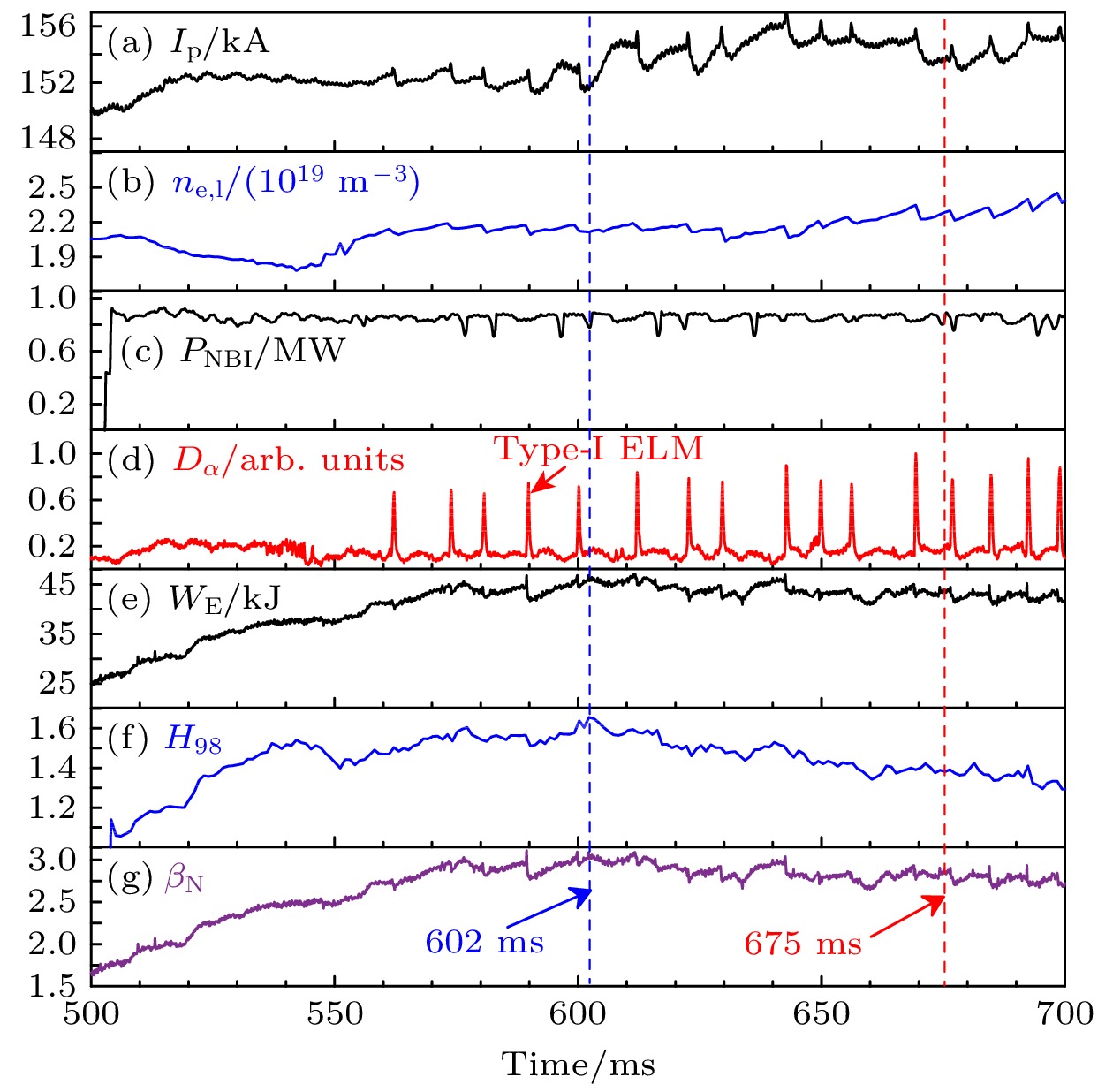
 DownLoad:
DownLoad:
